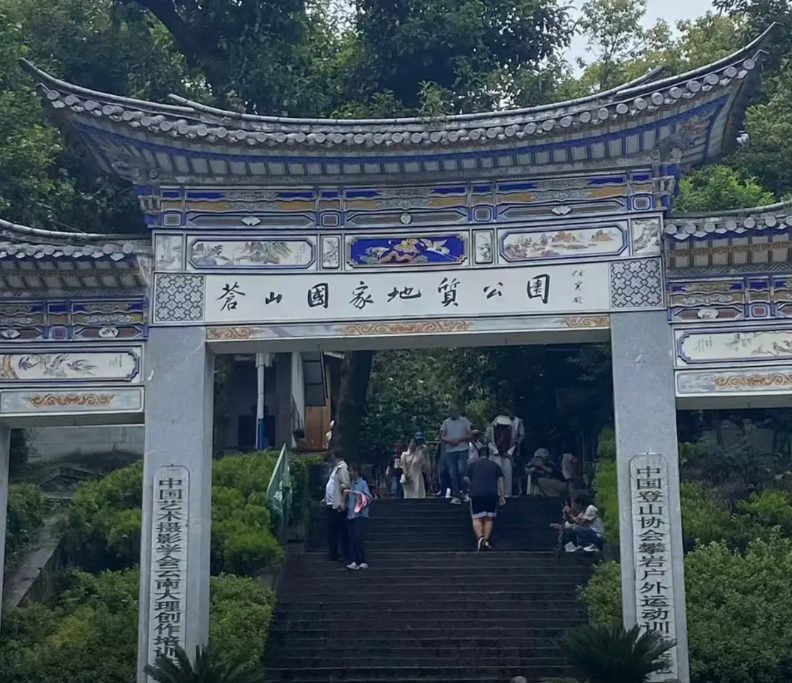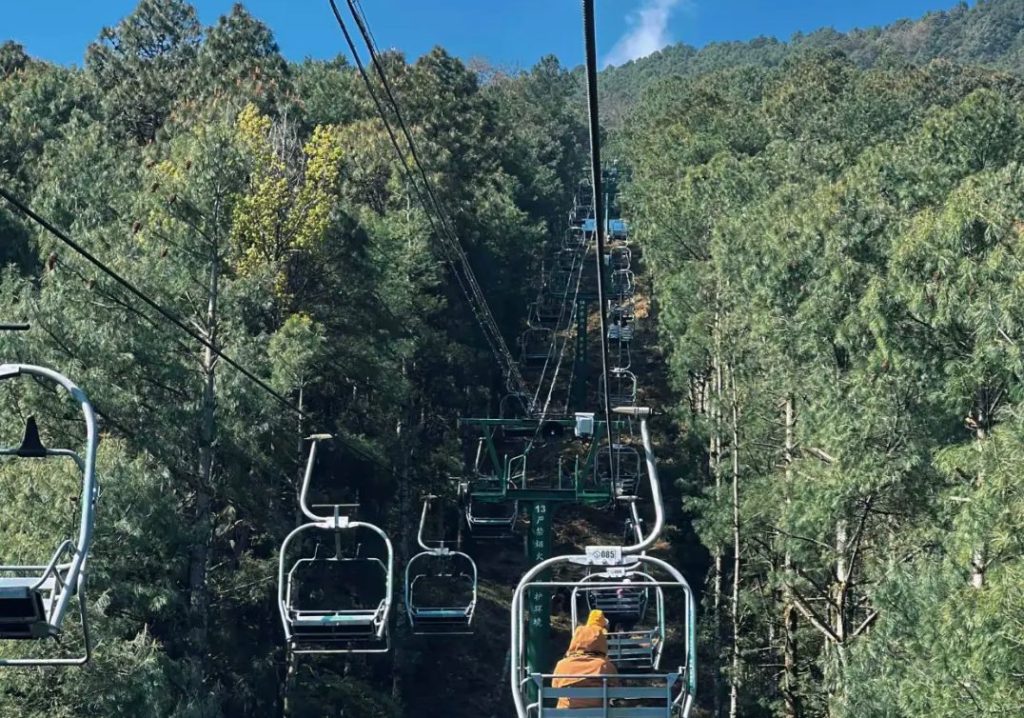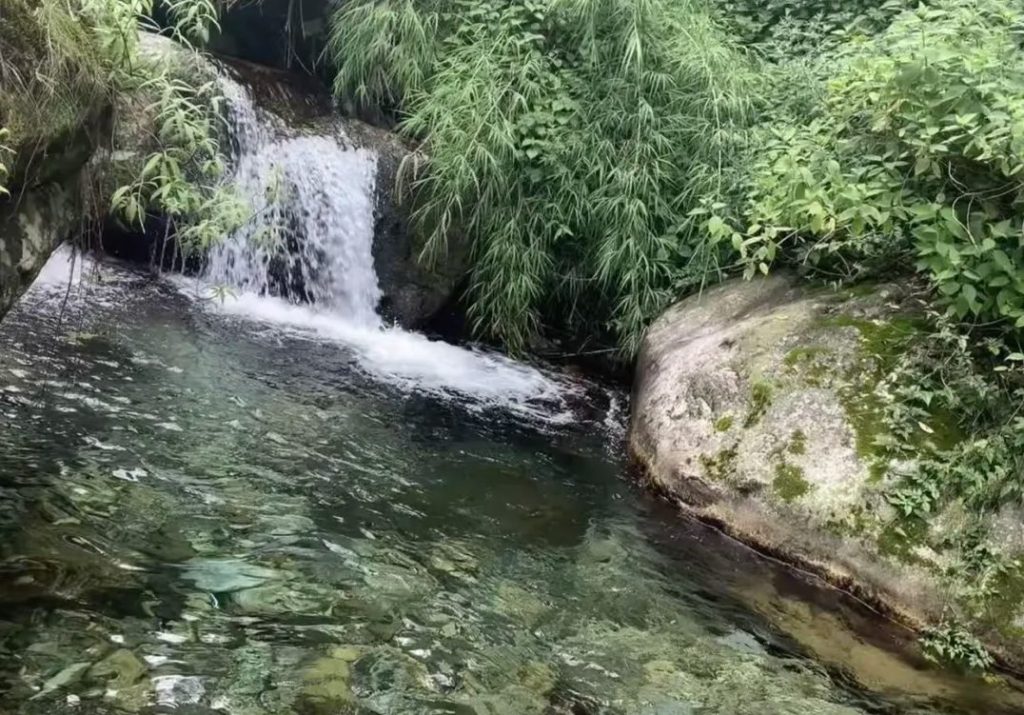Dali Cangshan Mountain has nineteen peaks, the main peak Malong Peak is 4122 meters above sea level.
There is a stream between every two peaks of Cangshan Mountain, constituting the unique landscape of “19 peaks and 18 streams” in Cangshan Mountain.
Northwest of Cangshan Mountain is the Qinghai-Tibet Plateau that stretches for more than 1,000 kilometers above 4,000 meters above sea level.
To the southeast of Cangshan Mountain is the Yunnan-Guizhou Plateau with an average altitude of 2,000 meters.
Due to the majestic Himalayan mountain system in the Cangshan Mountain end, south of Cangshan Mountain, no mountain range to reach a height of 3500 meters, so Cangshan Mountain is known as “the roof of the roof of the world”.
On the east side of Dali Cangshan Mountain is the Erhai Lake. Cangshan Mountain and the Erhai Lake complement each other, which is the result of the difference between the earth’s crust and the rise and fall of the earth’s crust.
The Cangshan Mountain and the Erhai Lake form a beautiful highland landscape.
Table of Contents

Dali Cangshan Mountain World Geopark
Geological Wonders
Cangshan Mountain is one of the youngest orogenic belts in the Hengduan Mountains, witnessing the magnificent epic of the collision between the Indian and Eurasian plates.
The mountains here are made of ancient metamorphic rocks, which have been weathered and eroded over millions of years to form steep peaks and deep canyons.
Geologists have discovered well-preserved remnants of Quaternary glaciers here – U-shaped valleys, ice buckets, bladed ridges and other landforms that record the biting scent of Earth’s last ice age.
Ecological wonders
From the subtropical evergreen broad-leaved forest at an altitude of 2,000 meters to the desert of flowstone beach above 4,000 meters, Cangshan Mountain possesses a complete spectrum of vertical natural belts.
On the hiking route, you will pass through cloudy fir forests (2,500 meters above sea level), encounter a sea of alpine azaleas and spring flowers (3,000 meters above sea level), and finally arrive at the exposed basalt columnar joints area (3,500 meters above sea level).
This vertical ecology of “four seasons in one mountain” makes Cangshan Mountain a natural laboratory for the study of biodiversity.
Cultural Eggs
During the period of Nanzhao Kingdom, Duan’s royal family built the Wuwei Temple here, which still preserves the stone carvings of the martial arts charts of “Six Chakras of the Divine Sword”.
For fans of Jin Yong, this is not only the birthplace of the “One-Yang Finger”, but also the prototype of the “Luang Mischief” in “The Eight Books of the Dragon” – the caverns along the Muo Dianxi River are still marked with the words of martial arts fans in various languages.
The cave is still home to the “secret manuals of martial arts” written by martial arts fans in different languages.

Travel Route
Day 1: Cloud Corridor Hike
Climb to the top by Sensory Ropeway
(Ticket includes Cangshan Geopark RMB 35 + Ropeway RMB 100, combined ticket recommended)
This pulsating ropeway, the longest in Asia, will take you through the clouds at a speed of 6 meters per second.
Early in the morning is recommended, as there is an 80% chance of encountering “Jade Belt Clouds” – a stratospheric fog that wraps around the mountainside like a white silk ribbon, which is how the “Jade Belt Cloudwalk” got its name.
Jade Belt Cloudwalk Hiking
This 4.5-kilometer “air corridor” is 2,920 meters above sea level and is the essence of Cangshan Mountain:
Qingbi Stream: The spectacle of “Three Pools of Water” written by Xu Xiake reaches its peak during the rainy season – the three-stacked waterfalls cascading down the cliffs, the emerald-colored pools and the reddish-colored Danxia form a strong visual impact.
Seven Dragon Maiden Pool: Through the primitive fir forest, seven levels of blue pools like scattered emerald. The local Bai people believe that it was here that Duan Yu met the statue of the “Fairy Sister” and acquired the Northern Darkness Divine Power.
Zhonghe Temple Vegetarian Food: Avoiding the crowds at the Internet-renowned Silent Illumination Temple, this 1,000-year-old temple’s vegetarian food (RMB 20/person) is a Zen cuisine made with matsutake mushrooms and fungus. After the meal, you can enjoy a panoramic view of the Cangshan Mountains and Erhai Lake from the observation deck, and on a clear day, you can even see Jizhu Mountain, 50 kilometers away.

Day 2: Explore the glacier ruins
Washimatan Ropeway Experience
(RMB 340 for the whole trip, including the mid-station Seven Dragon Lady Pool)
This is one of the tourist ropeways with the largest altitude difference in the world, going from 2,200 meters above sea level straight to 3,920 meters. It is recommended to carry:
Windproof jacket (wind speed at the top of the mountain can be up to grade 8)
Oxygen cylinder (available at scenic spots, essential for those with plateau reaction)
Glacier ruins hiking
The remains of the Quaternary glacier, the southernmost in China, are preserved here:
Wash Horse Pool: Legend has it that Kublai Lie washed his horse here during his southern expedition. Nowadays, the water of the pool reflects the snowy peaks, and the alpine azaleas in May-June color the slopes of the mountain into a pinkish-white snowfield.
Sea of Azaleas: Cangshan boasts 31 species of alpine azaleas, of which the yellow cup azalea and milky yellow azalea are endemic.

Must Experience
Cangshan Snow Tea Handmade
In April, you can pick tea along the Peach Creek Valley, learn how to make “Cangshan Snow Tea” from white tea farmers: killing, twisting, drying, and then bring a bag of your own fried tea down the mountain.
Tie-dye Workshop
With a Cangshan Mountain ticket, you can visit the Zhoucheng Tie & Dye Museum for free, and make a blue-dyed square scarf in the “martial arts style” – how about using Duan Yu’s “Lingbo Weibu” pattern?
Tips
Best Season: May-June (Azalea Sea), November (Sea of Clouds Season)
Transportation Tips: Take a taxi from Dali Ancient City to Sentong Ropeway for about 15 RMB, and rent an electric car (50 RMB/day) to travel freely through the various ropeway stations.
Taboo Tips: Feeding wild animals is prohibited in the area of the Seven Dragon Maidens Pool, and please do not photograph Buddha statues in Zhonghe Temple.
Hidden Benefit: Purchase a ropeway ticket and receive a free “Cangshan Plant Illustrated Guide”, which can be scanned to listen to a bilingual commentary.
